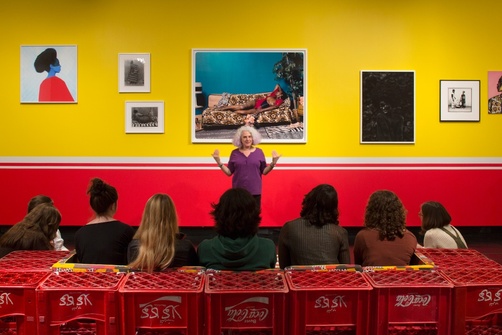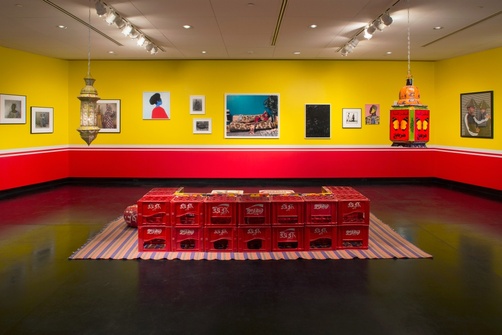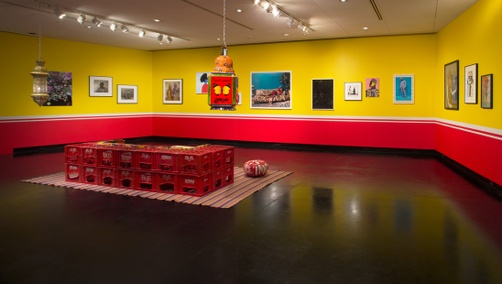



Installation views




Object Labels
Malick Sidibé began his life herding animals in a small village in Mali before the village chief chose him to go to the white school in Yanfolila for an education. Sidibé was attracted to art as soon as he began school, doing drawings for official events while in high school. Those charcoal drawings helped Sidibé get accepted to study at the Institut National des Arts de Bamako. While at the Institut, the young artist was noticed by photographer Gérard Guillat-Guignard, whose mentorship profoundly influenced Sidibé’s artistic medium and career.
Sidibé was incredibly prolific in his work. His street photography captures the vibrancy and excitement of life in Bamako, Mali’s capital, during the mid-twentieth century. He captured his subjects, the lively youth of the city, in the streets, nightclubs, and beaches of Bamako after the country’s independence from France in 1960. Sidibé captured the ethos and energy of cultural freedom, optimism, and enthusiasm at this time. Within this context of independence, an African like Sidibé photographing other Africans helped redress the colonial power dynamic.
As time passed and Sidibé received more commissions from middle-class families wanting documentation of their lives, Sidibé moved inside to a studio practice. His use of patterned backdrops served as the perfect milieu for his young subjects, as they were often dressed in patterns that seem to vibrate in relation to the backdrops. The excitement of this vibration mirrors the excitement in the eyes of the subjects. The positive energy and comfortable environment of the studio is clear, for example, in Vues de dos—Juin, as the subjects’ backs are facing the camera. This was a scandalous pose for a woman to be in at this time, and would only have been undertaken in an environment where the subjects could be at ease.
Africa Pop Studio positions Sidibé as a source and touchstone for a new generation of artists who have adapted his aesthetics and spirit to establish their individuality and address expansive, global contemporary issues. His influence on artists practicing today in Africa and the diaspora, such as those in this exhibition, cannot be underestimated.
From the exhibition: Africa Pop Studio (April 1 – April 23, 2017)
Malick Sidibé began making photographs when portrait photography was understood as a a way to express status both in the present and as a memento for posterity. An idea that originated with the portraiture of medieval and Renaissance Europe, when royalty was painted surrounded by their wealth and treasures, this idea reached Mali through Western occupation and colonization and was transformed into its own genre there. In the 1950s, Sidibé was commissioned to photograph people just after they had bought new clothes or had their hair done in a new fashion— the vocabulary of importance for people in the capital, Bamako, at the time.
However, in the 1960s and beyond, many young people in Bamako wanted to align themselves with the world outside Mali. They looked toward popular culture in the United States and Europe as an emblem of progress. Sidibé felt a genuine connection with these young people and saw the energy in their changing worldviews. They invited him to their parties, and he was able to record moments of their lives that were never before captured with a camera. His portfolio is stocked with photos of young Bamakoise hanging out or dancing, alongside studio portraits of the same men and women wearing traditional clothing. It was important to him that his studio be a welcoming, social center for all facets of Bamakoise life.
This change in values and lifestyle was directly connected to the recent independence of Mali, which was under French colonial rule from 1892 until 1960. These photographs capture Mali’s transition from a French colony into a young, independent, and determinedly modern nation. Sidibé’s subjects are both witness to and participants in this political and social transformation. The sitters are united by a pervasive and palpable sense of self-possession and agency. Sidibé aided this fledgling self-determination through posing and props, stating, “I didn’t want my subjects to look like mummies. … When you look at my photos, you are seeing a photo that seems to move before your eyes.”
–Jonah Jablons ’17, Alicia Russo ’17, and Sanjana Gothi ‘17
From the exhibition: If I Had Possession Over Judgement Day: Collections of Claude Simard (April 22 – September 24, 2017)
Ongoing Research



